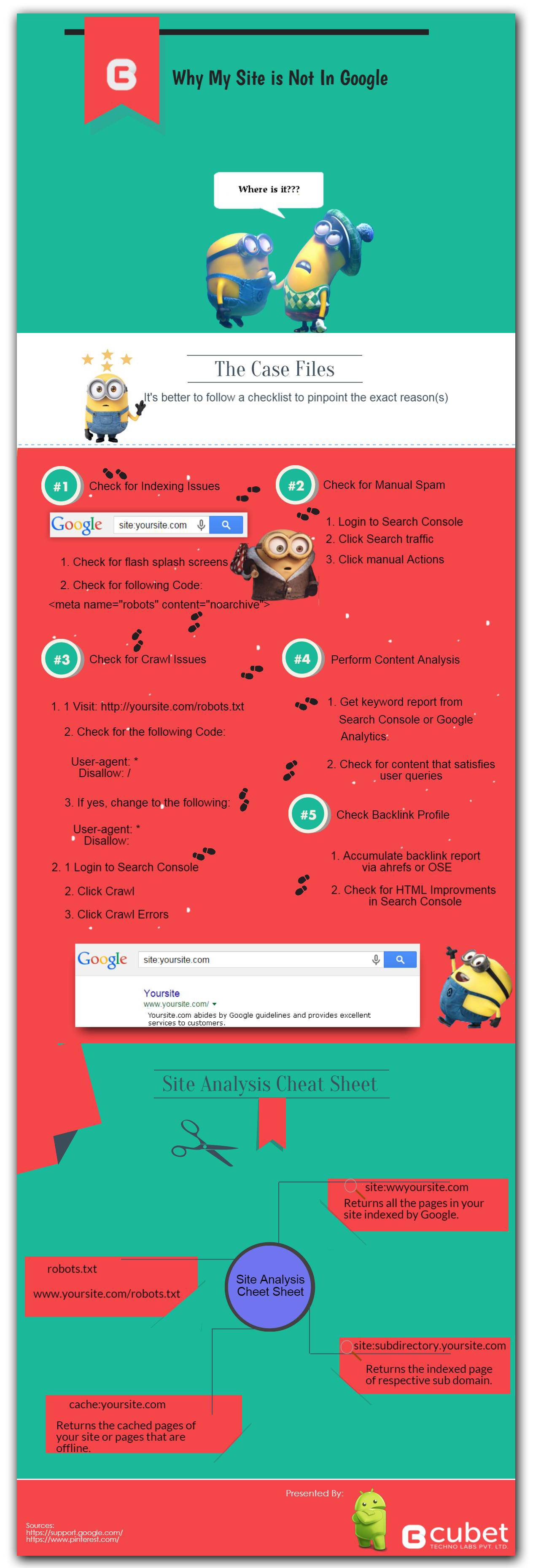Why My Site is not Ranking in Google (Infographics)?
So, it’s another day in the office for me, skimming through the web and trying to keep myself updated with the latest SEO fads. While on the run, I came across several discussions where people constantly fretted about how their site was not on SERPs, and what really made it strange for me was that some of these people had even optimized their site for search engines. The very next thing I did was to Google “why my site is not in Google” and yes I found tons of blogs and solutions to the issue. Now, any individual looking for a solution can find it an overwhelming task when it comes to grabbing the right information from these many blogs. So, obviously, you have less than a minute to convince or grab the attention of these people looking for solutions. To me, something like an infogrpahics is going to help the cause here.

Check for Indexing
The minute you suspect that your site is not in Google, the first thing you need to do is a site search. Go to Google and perform this search:”site:yoursite.com”. If Google returns a result with the pages of your site, then it is still indexed in Google. On the flip side, if none of the pages in your site is returned for this query, there is a possibility that Google has taken an action against your site for violating the Google Search Console Guidelines.
Check for Manual Spam Actions
Once you don’t see your site after performing a site search on Google, the next step is to check for Manual Spam Actions.
For the cause, you need to login to the Google Search Console (previously Google Webmaster Tools).
Click Manual Action Reports to check for Manual Spam Actions.
Check for Crawl Issues
Googlebot crawls your site on a regular basis and adds new pages to its index. On some occasions, we don’t want certain pages in your site to be indexed on Google when they are under development, broken etc. As webmasters, we have the option to guide the Googlebot by telling it which pages in your site that you wish to be indexed and which not. For the cause, we use a protocol called robot.txt. To sum up, robots.txt is an exclusion protocol that is used to direct the Googlebot on how to index & crawl the pages in your site. You can find the robots.txt of your site here: yoursite.com/robots.txt
The robots.txt file of a site which allows all the pages in it to be crawled will look like this:
User-agent: * Disallow:
The robots.txt file of a site which does not allow any pages in it to be crawled will look like this:
User-agent: * Disallow: /
You can also text for robots.txt crawl issues and crawl errors via Google Search Console.
To check Crawl Errors:
Login to Google Search Console
Click on Crawl->Crawl Errors
To check whether the robots.txt file that corresponds to your site blocks access to any of the pages in your site by accident, you can use robots.txt Tester.
To check robots.txt issues:
Login to Google Search Console
Click on Crawl->robots.txt Tester
Perform Content Analysis
Make sure that the content, title and alt tags falls within a common groove. Give priority to the content, try to sort out how people try to reach out to services or products that you have on offer. You can use the “Search Analytics” feature in Google Search Console to get a list of keywords via which people find your site. Try to make the content more compelling and concise.
Ensure that there are no duplicate content throughout the site. Check whether any piece of content has been blacklisted as adult content by using safe search feature.
Check Backlink Profile
Check the backlink profile of your website using tools like ahrefs and open site explorer. See that your site has a strong backlink profile with less or zero backlinks from spammy sites. You can also use Search Console to get a report on your backlink profile. Sort out spammy backlink and use the Disavow Tool of search console to remove the spammy backlinks.
Spread the word about your site and get backlinks from reputed and relevant niches. Earning backlinks to your site can speed up the indexing process.
Not finding your website indexed on Google doesn’t mean the end of the world. Give yourself some time to breathe and invest more time and effort to bring out the core reasons. A planned and patient approach to tackle this issue is always wise and can get you back on track in no time.
Embed this infographic on your site:
</p><br /> <p><img src=”https://cubettech.com/wp-content/uploads/2015/09/Why-My-Site-is-Not-in-Google-Infographics.jpg” width=”540″></p><br /> <p>Why My Site is not Ranking in Google (Infographics) – An infographic by the team at <a href=”http://blog.cubettech.com/”>Why My Site is not Ranking in Google (Infographics)</a></p><br /> <p>